

Ai caution. Www.newsweek. A-Call-for-Caution-as-Artificial-Intelligence-Makes-Its-Way-into-Government. Have a question about taxes, vehicle licensing or simply need the phone number for a state agency?

If you live in Mississippi, just ask Alexa, Amazon’s digital assistant that has been programmed to also work with state and local governments. In fact, Mississippi is one of several governments that uses so-called chatbots to handle a range of basic but frequently asked questions. In Utah, teenagers can solicit help reviewing questions that might be on a driver’s test. In Los Angeles, residents can get detailed information about city-sponsored events. Top-scientists-call-for-caution-over-artificial-intelligence. Those who have already signed the letter include Stephen Hawking, Elon Musk, the co-founders of DeepMind, Google's director of research Peter Norvig and Harvard professor of computer science David Parkes.
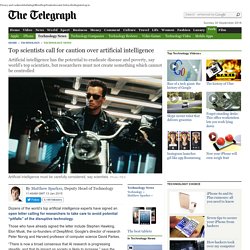
“There is now a broad consensus that AI research is progressing steadily, and that its impact on society is likely to increase,” says the letter, published by The Future of Life Institute. “The potential benefits are huge, since everything that civilisation has to offer is a product of human intelligence; we cannot predict what we might achieve when this intelligence is magnified by the tools AI may provide, but the eradication of disease and poverty are not unfathomable. Because of the great potential of AI, it is important to research how to reap its benefits while avoiding potential pitfalls. The paper suggests that it “may be desirable to retain some form of meaningful human control” over intelligent machines designed to kill. What are Issac Asimov''s three laws of robotics? Are they purely ficticious or is there scientific credence to them?
What are Issac Asimov's three laws of robotics?
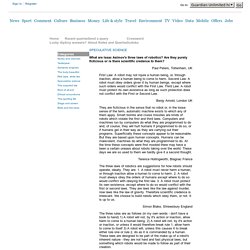
Are they purely ficticious or is there scientific credence to them? Paul Peters, Tottenham, UK. Do We Need Asimov's Laws? In 1942, the science fiction author Isaac Asimov published a short story called Runaround in which he introduced three laws that governed the behaviour of robots.
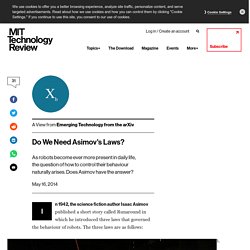
The three laws are as follows: 1. The Three Laws of Robotics by Isaac Asimov. The original Three Laws of Robotics were coined by Isaac Asimov in his 1942 short story Runaround.
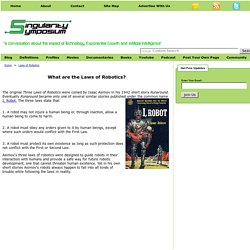
Eventually Runaround became only one of several similar stories published under the common name I, Robot. The three laws state that: 1. A robot may not injure a human being or, through inaction, allow a human being to come to harm. 2. 3. M.youtube. M.youtube. Three Laws of Robotics. Set of rules devised by the science fiction author Isaac Asimov This cover of I, Robot illustrates the story "Runaround", the first to list all Three Laws of Robotics First Law A robot may not injure a human being or, through inaction, allow a human being to come to harm.
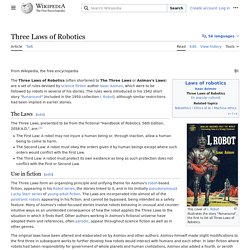
Second Law A robot must obey the orders given it by human beings except where such orders would conflict with the First Law. Third Law A robot must protect its own existence as long as such protection does not conflict with the First or Second Law.[1] The original laws have been altered and elaborated on by Asimov and other authors. Zeroth Law. Isaac Asimov's "Three Laws of Robotics" Isaac Asimov. American writer (1920–1992) Isaac Asimov (;[b] c. Ray Kurzweil. Raymond Kurzweil ( KURZ-wyle; born February 12, 1948) is an American inventor and futurist.
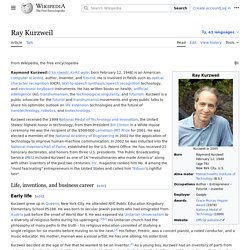
He is involved in fields such as optical character recognition (OCR), text-to-speech synthesis, speech recognition technology, and electronic keyboard instruments. Biotechnology. "Bioscience" redirects here.
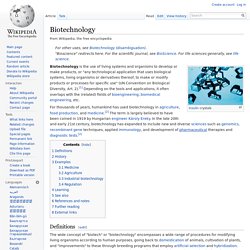
For the scientific journal, see BioScience. For life sciences generally, see life science. Robotics. Robotics is the branch of mechanical engineering, electrical engineering and computer science that deals with the design, construction, operation, and application of robots,[1] as well as computer systems for their control, sensory feedback, and information processing.
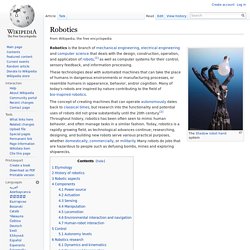
These technologies deal with automated machines that can take the place of humans in dangerous environments or manufacturing processes, or resemble humans in appearance, behavior, and/or cognition. Many of today's robots are inspired by nature contributing to the field of bio-inspired robotics. The concept of creating machines that can operate autonomously dates back to classical times, but research into the functionality and potential uses of robots did not grow substantially until the 20th century.[2] Throughout history, robotics has been often seen to mimic human behavior, and often manage tasks in a similar fashion. Nanotechnology. Nanotechnology ("nanotech") is the manipulation of matter on an atomic, molecular, and supramolecular scale.
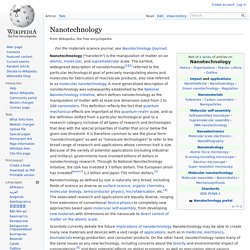
The earliest, widespread description of nanotechnology[1][2] referred to the particular technological goal of precisely manipulating atoms and molecules for fabrication of macroscale products, also now referred to as molecular nanotechnology. A more generalized description of nanotechnology was subsequently established by the National Nanotechnology Initiative, which defines nanotechnology as the manipulation of matter with at least one dimension sized from 1 to 100 nanometers. This definition reflects the fact that quantum mechanical effects are important at this quantum-realm scale, and so the definition shifted from a particular technological goal to a research category inclusive of all types of research and technologies that deal with the special properties of matter that occur below the given size threshold. Origins[edit] Comparison of Nanomaterials Sizes. Life extension. The sale of putative anti-aging products such as nutrition, physical fitness, skin care, hormone replacements, vitamins, supplements and herbs is a lucrative global industry, with the US market generating about $50 billion of revenue each year.[2] Some medical experts state that the use of such products has not been proven to affect the aging process, and many claims of anti-aging medicine advocates have been roundly criticized by medical experts, including the American Medical Association.[2][3][4][5][6] Public opinion[edit] Life extension is a controversial topic due to fear of overpopulation and possible effects on society.[10] Religious people are no more likely to oppose life extension than the unaffiliated,[11] though some variation exists between religious denominations.
A Spring 2013 Pew Research poll in the United States found that 38% of Americans would want life extension treatments, and 56% would reject it. Futures studies. Moore's law is an example of futures studies; it is a statistical collection of past and present trends with the goal of accurately extrapolating future trends. Futures studies (also called futurology and futurism) is the study of postulating possible, probable, and preferable futures and the worldviews and myths that underlie them. There is a debate as to whether this discipline is an art or science. In general, it can be considered as a branch of the social sciences and parallel to the field of history. In the same way that history studies the past, futures studies considers the future. Futures studies (colloquially called "futures" by many of the field's practitioners) seeks to understand what is likely to continue and what could plausibly change.
Technological singularity. Hypothetical point in time at which technological growth becomes uncontrollable and irreversible The technological singularity—also, simply, the singularity[1]—is a hypothetical point in time at which technological growth becomes uncontrollable and irreversible, resulting in unforeseeable changes to human civilization.[2][3] According to the most popular version of the singularity hypothesis, called intelligence explosion, an upgradable intelligent agent will eventually enter a "runaway reaction" of self-improvement cycles, each new and more intelligent generation appearing more and more rapidly, causing an "explosion" in intelligence and resulting in a powerful superintelligence that qualitatively far surpasses all human intelligence. I. J. Transhumanism. Artificial intelligence. Speech recognition. Speech synthesis.
Optical character recognition. Futurist. Inventor. Ray Kurzweil. Delaware General Corporation Law. History[edit] Other legal aspects[edit] Delaware has also attracted major credit card banks because of its relaxed rules regarding interest. Many U.S. states have usury laws limiting the amount of interest a lender can charge. Federal law allows a national bank to "import" these laws from the state in which its principal office is located.[6] Delaware (amongst others) has relatively relaxed interest laws,[7] so several national banks have decided to locate their principal office in Delaware.
iRobot. iRobot Corporation is an American advanced technology company founded in 1990 by three MIT graduates who designed robots for space exploration and military defense.[2] Incorporated in Delaware, the company designs and builds consumer robots for inside and outside of the home, including a range of autonomous home vacuum cleaners (Roomba), floor moppers (Braava), and other autonomous cleaning devices.[3] Rodney Brooks. H. G. Wells. Arthur C. Clarke.